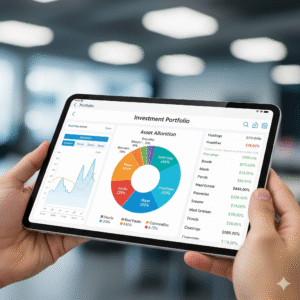The world of investing can feel like an exclusive club with a secret language. Words like “asset allocation,” “equities,” and “fixed income” are thrown around, leaving many beginners feeling overwhelmed and convinced that building a portfolio is something best left to the experts. But what if the single most powerful concept in modern investing was as simple as a piece of timeless advice: “Don’t put all your eggs in one basket”?
That, in essence, is the principle of diversification. It’s the strategy of spreading your investments across various assets to ensure that the poor performance of any single investment doesn’t sink your entire ship. Building a diversified portfolio is not about picking the next hot stock; it’s about creating a resilient, all-weather financial plan designed to grow your wealth steadily over the long term while helping you sleep at night.
This guide will demystify the process. We will break down the construction of a strong portfolio into six clear, actionable steps. From understanding yourself as an investor to selecting the right tools and maintaining your strategy, you’ll gain the confidence and knowledge to build a financial future on your own terms.
Step 1: The Foundation – Know Thyself as an Investor

Before you invest a single dollar, the most important analysis you’ll do is on yourself. Your portfolio should be a direct reflection of your personal financial situation, goals, and even your personality. Rushing this step is like building a house without a blueprint.
Define Your Financial Goals
Why are you investing? The answer to this question is the single most important driver of your strategy. Vague goals like “to make money” aren’t helpful. Get specific:
- Retirement: Are you investing for a comfortable retirement in 30 years? This long-term goal allows for a more aggressive, growth-oriented strategy.
- Buying a Home: Are you saving for a down payment in the next 5-7 years? This shorter timeframe requires a more conservative approach to protect your principal.
- College Savings: Are you investing for a child’s education in 15 years? This falls somewhere in the middle.
- General Wealth Building: Are you looking to build wealth for financial independence over the next two decades?
Write down your specific, time-bound goals. They will act as your North Star, guiding every decision you make.
Determine Your Time Horizon
Your time horizon is simply how long you have until you need to access your money. This is a critical factor in how much risk you can afford to take.
- Long-Term (10+ years): If your goal is decades away (like retirement for someone in their 20s or 30s), you have plenty of time to recover from market downturns. This long runway means you can take on more risk in pursuit of higher returns.
- Medium-Term (5-10 years): You have less time to bounce back from a major market correction. Your portfolio should be more balanced between growth and preservation.
- Short-Term (Less than 5 years): Money you need in the short term should not be exposed to significant market risk. The stock market is far too volatile for short-term goals. This money is better suited for high-yield savings accounts, CDs, or money market funds.
Honestly Assess Your Risk Tolerance
Risk tolerance is your emotional and financial ability to withstand drops in your portfolio’s value. It’s about your gut reaction to market volatility. Ask yourself:
- If I invested $10,000 and the market crashed, causing my portfolio to drop to $7,000, what would I do?
- a) Panic and sell everything to prevent further loss.
- b) Feel nervous but hold on, trusting the long-term plan.
- c) See it as a buying opportunity and invest more.
If you answered (a), you have a low risk tolerance. If you answered (b), you have a moderate risk tolerance. If you answered (c), you have a high risk tolerance. Be honest with yourself. Choosing a strategy that is too aggressive for your personality is a recipe for panic selling at the worst possible time.
Step 2: The Building Blocks – Understanding Asset Classes

Once you know yourself, it’s time to learn about your tools. Asset classes are the categories of investments that will form the building blocks of your portfolio. Each has a different risk-and-return profile and plays a unique role.
Equities (Stocks): The Engine for Growth
When you buy a stock, you are buying a small piece of ownership in a public company. The goal is for the company to grow and become more profitable, causing the value of your share to increase.
- Role in Portfolio: Primary driver of long-term growth.
- Risk Level: High. Stock prices can be very volatile in the short term.
- Sub-Categories:
- By Size: Large-Cap (big, stable companies), Mid-Cap, and Small-Cap (smaller, higher-growth potential but riskier).
- By Location: U.S. Stocks and International Stocks (from both developed and emerging markets). A truly diversified portfolio includes both.
Fixed Income (Bonds): The Stabilizer
When you buy a bond, you are essentially lending money to a government or a corporation. In return, they agree to pay you periodic interest payments and return your initial investment (the principal) at a future date.
- Role in Portfolio: To provide stability, generate income, and act as a shock absorber when the stock market falls. High-quality bonds often rise in value when stocks are in a panic.
- Risk Level: Low to Moderate. Much safer than stocks, but not entirely risk-free (subject to interest rate and inflation risk).
- Sub-Categories: U.S. Treasury Bonds (ultra-safe), Corporate Bonds (issued by companies), and Municipal Bonds (tax-advantaged).
Alternatives: The Diversifiers
This is a broad category for anything that doesn’t fit neatly into stocks or bonds.
- Role in Portfolio: To provide diversification that isn’t closely correlated with the stock or bond markets, and often to act as a hedge against inflation.
- Risk Level: Varies widely.
- Common Examples:
- Real Estate Investment Trusts (REITs): Companies that own or finance income-producing real estate. They allow you to invest in a portfolio of properties without being a landlord.
- Commodities: Raw materials like gold, oil, and agricultural products. Gold, in particular, is often seen as a safe-haven asset during times of economic uncertainty.
Step 3: The Blueprint – Your Asset Allocation Strategy
This is arguably the most important step in the entire process. Asset allocation is simply the decision of how you will divide your portfolio among the different asset classes (stocks, bonds, alternatives). Research has shown that your asset allocation decision is responsible for more than 90% of your portfolio’s long-term returns.
Your allocation should be a direct result of the goals, time horizon, and risk tolerance you defined in Step 1. Here are some sample allocation models:
Aggressive Allocation (High Risk Tolerance, Long Time Horizon)
- 80% Stocks: (e.g., 55% U.S. Stocks, 25% International Stocks)
- 20% Bonds: (e.g., U.S. Total Bond Market)
- Best for: Young investors in their 20s or 30s saving for retirement.
Moderate Allocation (Moderate Risk Tolerance, Medium Time Horizon)
- 60% Stocks: (e.g., 40% U.S. Stocks, 20% International Stocks)
- 40% Bonds: (e.g., U.S. Total Bond Market)
- Best for: Investors in their 40s or 50s, or those with a medium-term goal. This is often called a “60/40” portfolio and is a classic balanced approach.
Conservative Allocation (Low Risk Tolerance, Short Time Horizon)
- 30% Stocks: (e.g., 20% U.S. Stocks, 10% International Stocks)
- 70% Bonds: (e.g., U.S. Total Bond Market, Short-Term Bonds)
- Best for: Investors nearing or in retirement who are focused on preserving capital and generating income.
Step 4: The Tools – Selecting Your Specific Investments

Now that you have your blueprint (your asset allocation), it’s time to choose the tools to build it. For the vast majority of investors, especially beginners, the best tools are not individual stocks. Instead, they are low-cost index funds and Exchange-Traded Funds (ETFs).
An index fund or ETF is a single investment that holds hundreds or even thousands of different stocks or bonds, designed to track a specific market index (like the S&P 500).
Why are they the best choice?
- Instant Diversification: By buying one share of a Total Stock Market ETF, you instantly own a tiny piece of thousands of U.S. companies. It’s the ultimate “all your eggs in many baskets” solution.
- Extremely Low Cost: Because they are passively managed (not run by a high-paid manager picking stocks), their annual fees (expense ratios) are incredibly low. This means more of your money stays in your pocket, working for you.
- Simplicity: You can build a globally diversified portfolio using just three or four core funds.
Example Portfolio using ETFs:
To achieve a “Moderate Allocation” (60/40), an investor could use:
- 40% in a Total U.S. Stock Market ETF (like VTI or ITOT)
- 20% in a Total International Stock Market ETF (like VXUS or IXUS)
- 40% in a Total U.S. Bond Market ETF (like BND or AGG)
With just three simple, low-cost funds, you have created a sophisticated, globally diversified portfolio.
Step 5: The Execution – Opening an Account and Investing
With your plan in hand, it’s time to take action.
- Choose a Brokerage: Open an account with a reputable, low-cost brokerage firm like Vanguard, Fidelity, or Charles Schwab. These firms offer a wide selection of no-commission ETFs and mutual funds.
- Fund the Account: Link your bank account and transfer the initial amount you plan to invest.
- Place Your Trades: Enter the ticker symbols for the ETFs you chose in Step 4 (e.g., VTI), specify the dollar amount you want to invest in each, and place your orders.
- Automate It: The most powerful thing you can do is set up automatic, recurring investments from your bank account to your brokerage account. This implements a dollar-cost averaging strategy, taking emotion out of the equation and ensuring you invest consistently.
Step 6: The Long Game – Maintenance and Rebalancing

Building your portfolio is not a one-time event; it’s the beginning of a long-term discipline. Your portfolio needs occasional check-ups to stay healthy. This is done through rebalancing.
Over time, your portfolio’s allocation will “drift.” In a year when stocks do well, your 60% stock allocation might grow to become 65% of your portfolio. This means you are now taking on more risk than you originally intended.
Rebalancing is the process of trimming your winners and adding to your underperformers to bring your portfolio back to its target allocation. In the example above, you would sell 5% of your stocks and use the proceeds to buy bonds. This forces you to systematically buy low and sell high. A good rule of thumb is to review your portfolio and rebalance once a year.
Discipline is Your Superpower
Building a diversified portfolio is one of the most effective steps you can take to secure your financial future. The process isn’t about complex algorithms or secret stock tips. It’s about understanding your own goals, creating a sensible plan based on timeless principles, and, most importantly, having the discipline to stick with that plan through good times and bad.
The market will go up, and it will go down. But a well-diversified portfolio is built to withstand the storms and capture the growth of the global economy over the long run. By following these steps, you are not just investing your money—you are investing in your future.







